It’s hard to deny that there is a movement happening in the world that is steering away from synthetic products like plastics and parabens and heading toward natural ingredients in pretty much everything we use.
For example, more people are moving away from heavy-duty cleaning solutions that leave chemicals in the air, down the drain, and in our bodies. White vinegar and water provide a healthy alternative that does the job just as well and doesn’t involve possible harmful ingredients.
So, if we as a society are trying to go natural when it comes to cleaning supplies, food for our pets and ourselves, then it seems that using organic body products is the next logical step.
If you are a DIY fan like I am, then the idea of making natural shampoo at home not only sounds like fun, it’s a great way to save some money. We put together a list of nineteen recipes for an organic shampoo that anyone could whip together.
Basic Shampoo Ingredients
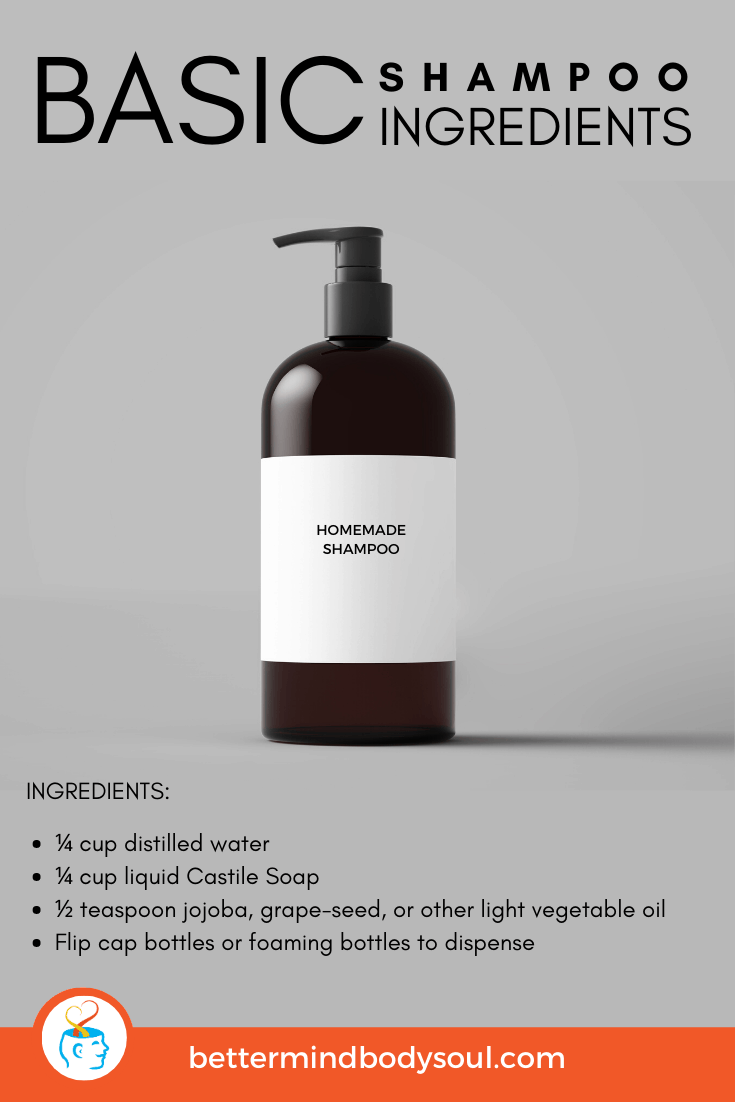
Ingredients
¼ cup distilled water
¼ cup liquid Castile Soap (you can use unscented or your favorite)
½ teaspoon jojoba, grapeseed, or other light vegetable oil
Flip cap bottles or foaming bottles to dispense
Our first recipe is going to get us started on simple ingredients for an easy basic shampoo, which works for all kinds of hair. Jojoba oil is especially wonderful for the hair because it is chock full of vitamins that will bring your strands nourishment like C, B vitamins, and E. It also has ample supplies of copper and zinc and has been known to add strength to hair.
Directions
Mix all the ingredients. Store in a bottle. Shake before use. This mixture isn’t as thick as commercial shampoos.
Natural Shampoo (Coconut Milk)
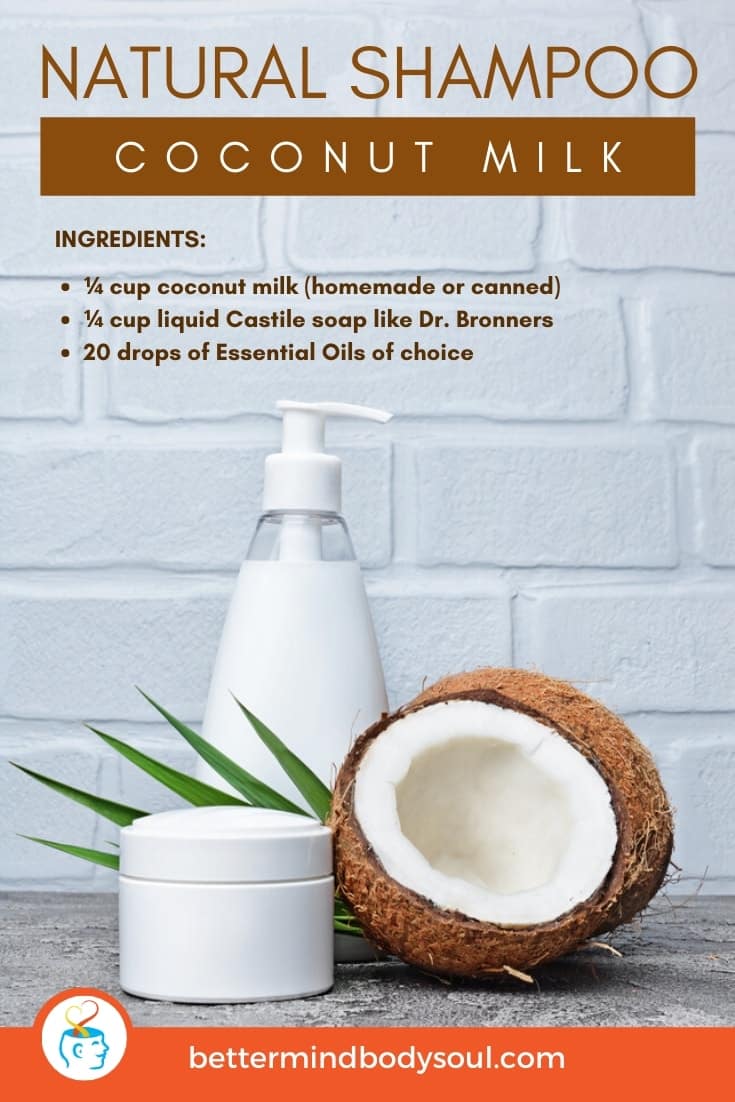
Ingredients
¼ cup coconut milk (homemade or canned)
¼ cup liquid Castile soap like Dr. Bronners
20 drops of Essential Oils of choice
This shampoo brings the power of coconut milk, which is quite a healthier option for those locks that you love so much. Not only does it supply your hair with much-needed nutrients, but coconut milk will also promote hair growth by giving your hair follicles a boost. The essential oils allow you to create a special aroma that speaks to you.
Directions
Combine all ingredients in an old shampoo bottle or jar of some kind (pump soap dispensers and even foaming dispenser work well for this. If you use a foaming dispenser, add ¼ cup of distilled water). Shake well to mix. Keep in the shower for up to a month.
Baking Soda

Ingredients
1 Tbsp baking soda – We buy baking soda in bulk because we use a ton of it
1 cup water
This natural shampoo will work best for those of us who find our hair getting oily more often than not. Try not to overdo it with this recipe because baking soda can be abrasive and dry out your scalp. But it’s perfect if you find you have an excess of oil in your mane.
Directions
Mix ingredients together. We mix ours in double batches into a clean, repurposed shampoo bottle. Feel free to use whatever container you like, doubling up on ingredients until it’s full.
Egg Yolk
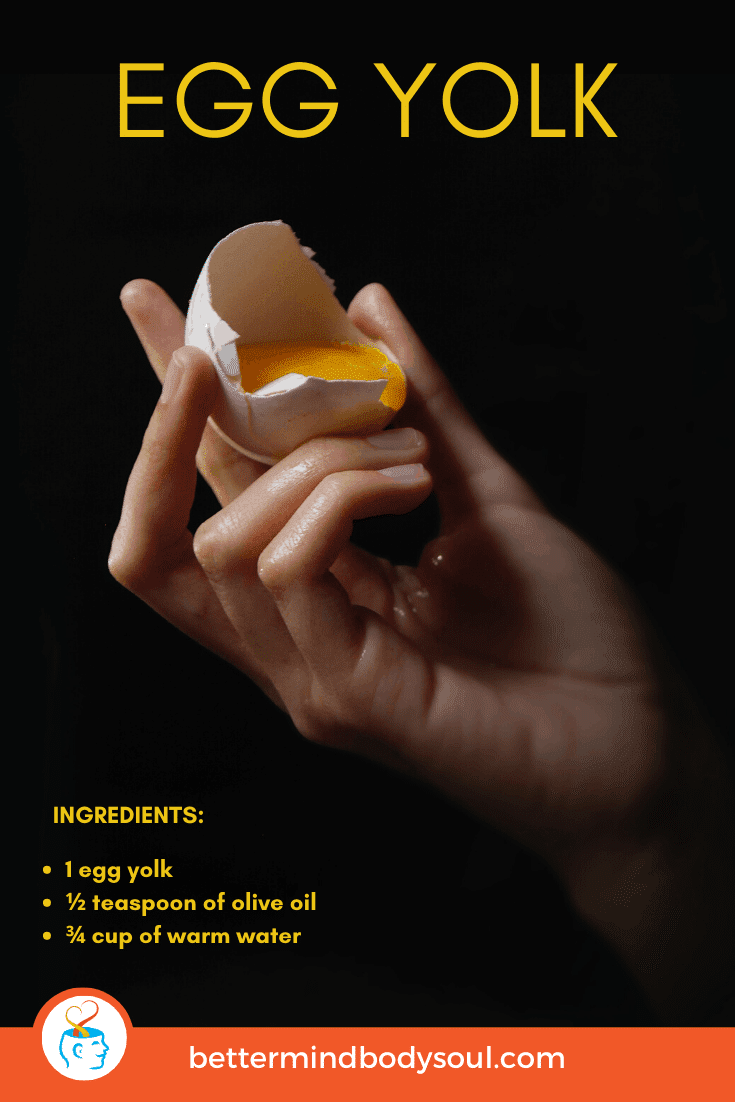
Ingredients
1 egg yolk
½ teaspoon of olive oil
¾ cup of warm water
Egg yolks are especially beneficial for hair, which is why they are used for this natural shampoo recipe. They are rich in vitamins and help when it comes to moisturizing. Vitamins A and E can be found in egg yolk, which adds to the benefits. Olive oil is full of antioxidants, so using it makes the scalp healthier while adding moisture to the hair.
Directions
Right before you wash your hair with your homemade shampoo, beat the egg yolk until it’s frothy, add oil and beat again, then add water slowly while beating. Pour the mix through wet hair, working it in with your fingers. Allow it to sit for a few.
Homemade Hair Rinse
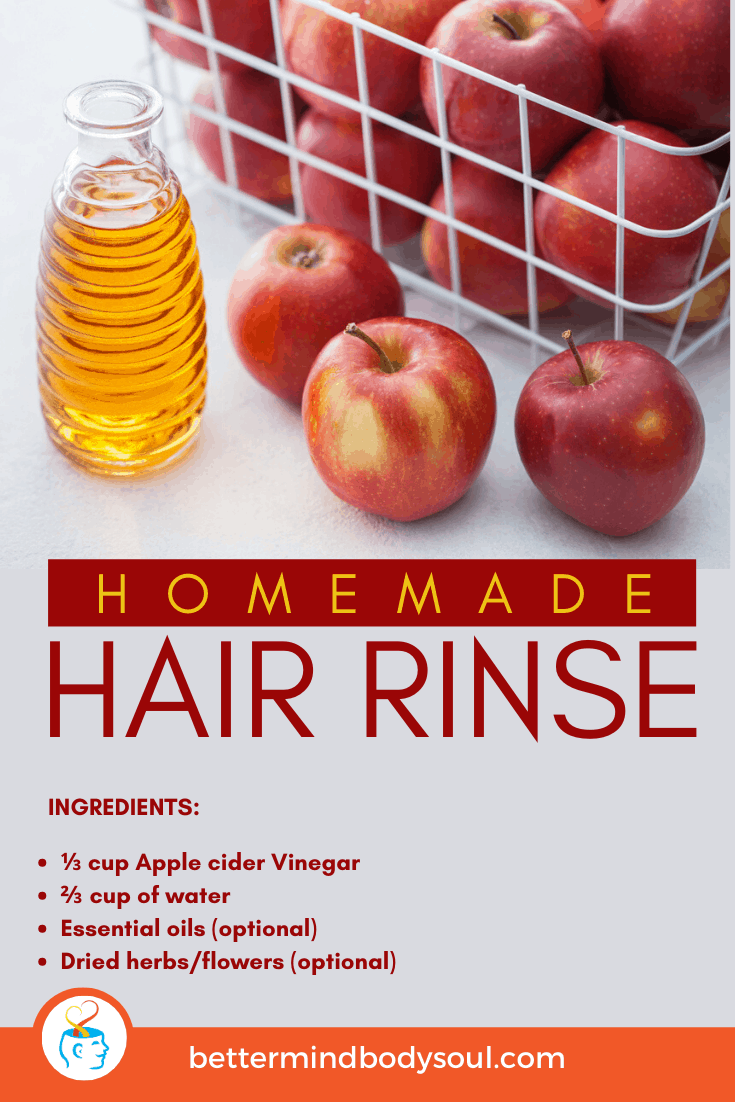
Ingredients
⅓ cup Apple cider vinegar
⅔ cup of water
Essential oils (optional)
Dried herbs/flowers (optional)
Directions
Combine the water, vinegar and essential oils if you are using. Store in a small spray bottle. You might want to adjust the ratio of the apple cider vinegar and water to create a mixture that works best with your hair.
Soothe Shampoo
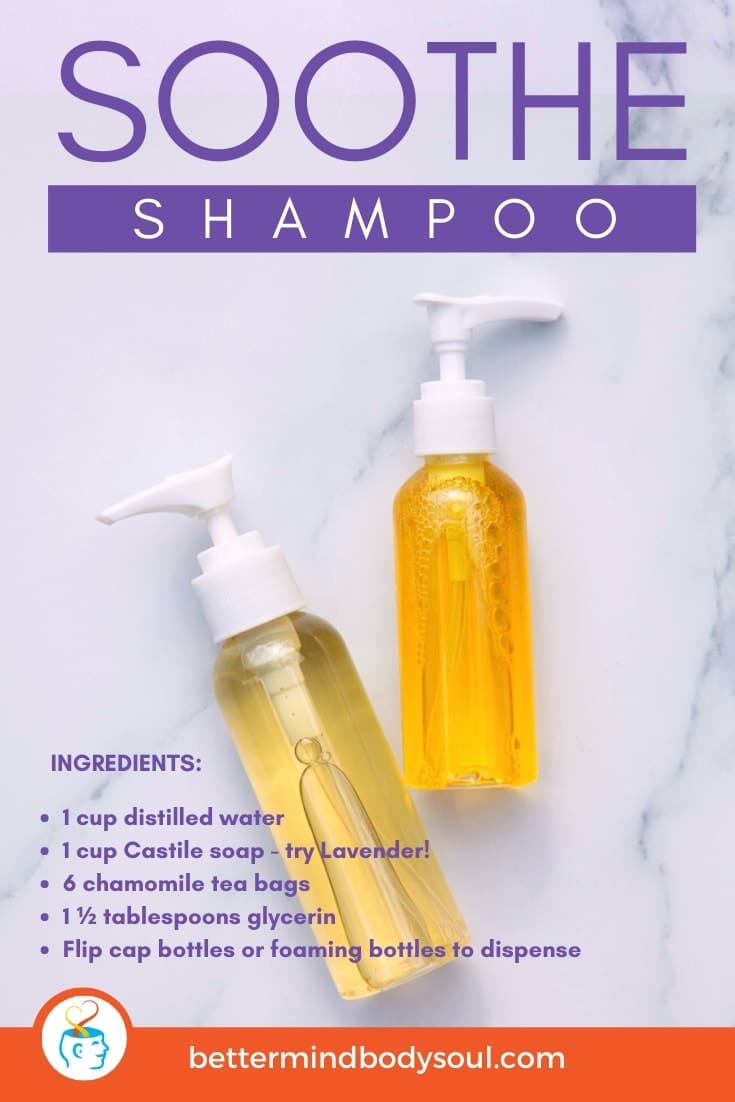
Ingredients
1 cup distilled water
1 cup Castile soap – try Lavender!
6 chamomile tea bags
1 ½ tablespoons glycerin
Flip cap bottles or foaming bottles to dispense
Glycerin works as a moisturizer and humectant for hair, especially in dry weather. The chamomile tea bags will soothe your irritated scalp and also put up a defense against dandruff. And recipes for natural dandruff shampoos are abundant. Chamomile also helps grow new hair, which is something we all love.
Directions
Steep the tea bags in 1 cup of boiling water for 20 minutes. Remove the tea bags and discard them. Add castile soap to the tea. Stir in glycerin until well blended. Keep in a dark, cool place in a sealed bottle.
Moisturizing DIY PH Balanced Shampoo
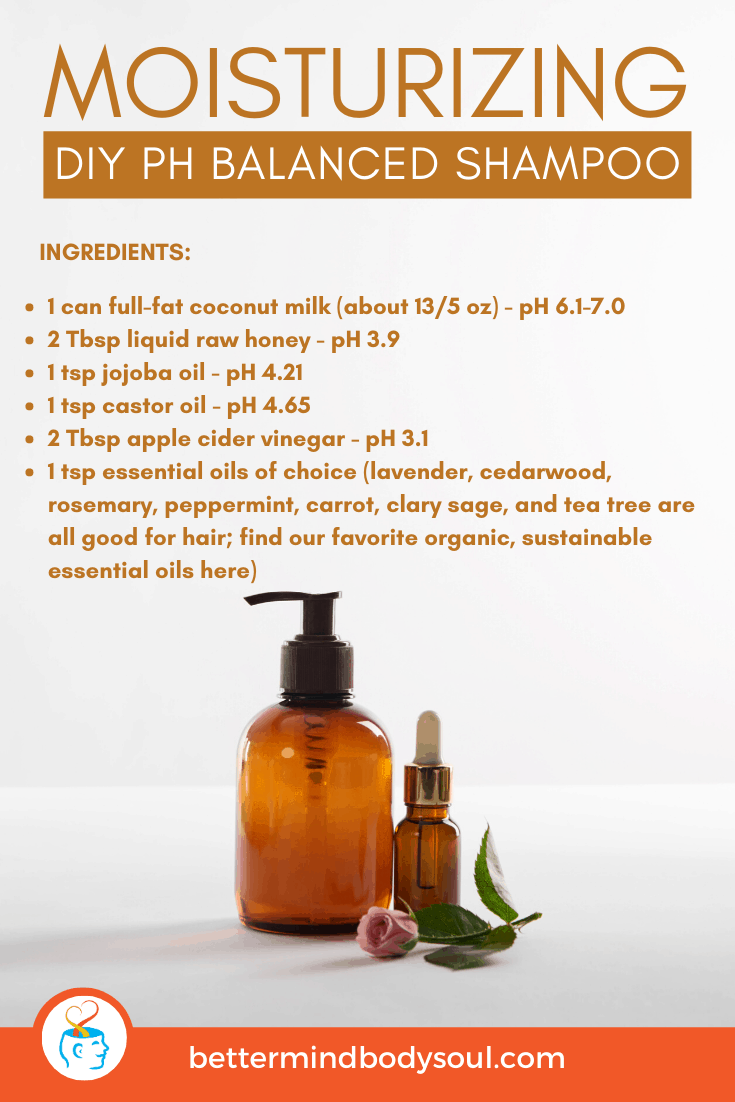
Ingredients
1 can full-fat coconut milk (about 13/5 oz) – pH 6.1-7.0
2 Tbsp liquid raw honey – pH 3.9
1 tsp jojoba oil – pH 4.21
1 tsp castor oil – pH 4.65
2 Tbsp apple cider vinegar – pH 3.1
1 tsp essential oils of choice (lavender, cedarwood, rosemary, peppermint, carrot, clary sage, and tea tree are all good for hair; find our favorite organic, sustainable essential oils here)
You may have never considered making a natural shampoo or about pH balance and how it applies to your hair. That’s fine, most people don’t. But when you have a pH that is off-kilter on your head, your hair is susceptible to bacteria and fungus. Your hair should have a pH balance somewhere between 4.5 and 5.5.
Directions
- Combine all ingredients in a mixing bowl and whisk until smooth. This will separate, so shake well before each use.
- To use, massage a small amount on the scalp and use your fingers or a comb to spread through the hair. Leave on for a few minutes before rinsing off.
- If your hair is naturally very oily, you can follow this up with an apple cider vinegar rinse made with ¼ cup apple cider vinegar and ¾ cup purified water.
Gentle pH Balanced Shampoo

Ingredients
5 Soap-nuts with seeds removed
3 cups distilled water
¼ to 1 teaspoon pure citric acid (please read the note below) grocery store
¼ to 1 teaspoon Xanthan Gum (please read the note below)
In the last recipe, we talked about the importance of pH and balance, which this one attempts to do gently. Soap nuts have been used in natural shampoo recipes for centuries. On top of balancing your hair pH, soap nuts are full of saponin, which contributes to shine, lusturious, and overall hair health.
Directions
Tools needed
Flip top bottles or empty plastic shampoo bottles.
Wooden spoon or non-reactive spoon.
Non-reactive saucepan
Glass bowl
Strainer
Immersion blends
Funnel
pH testing tape or pH meter
Pour 3 cups of distilled water into a non-reactive saucepan. Add 5 soap berries. Bring to a low boil. Reduce heat to simmer and simmer for 20 minutes. After 20 minutes, remove from heat and cool until you can comfortably touch the mixture.
Strain the mixture and place the soap-berrie into a shallow dish. Add ¼ teaspoon of citric acid. Add ¼ teaspoon xanthan gum. Mix using the immersion blender until all the lumps are gone and the mixture is frothy. Check the pH using the pH testing paper or pH meter. If the pH is too high add another ¼ teaspoon of citric acid.
If the consistency is too thin add ¼ teaspoon xanthan gum. Mix again using the immersion blender. Check the pH level again. Repeat process until you are happy with the pH level again. Repeat process until you are happy with the pH and the consistency of the shampoo.
Pour mixture into the shampoo bottle using the funnel.
All Natural pH Balanced Shampoo Recipe

Ingredients
1 can of Coconut Milk (or about 1 ½ cups if you like to make it yourself.) (like this)
1 ¾ cups pure aloe vera gel (like this)
Optional: Essential oils (learn how to get my favorite essential oils at wholesale prices here.)
Besides helping balance your hair pH, aloe vera gel is a wonderful ingredient when it comes to repairing damaged cells on the scalp, which is literally at the root of your hair health. This plant based ingredients also keeps your hair looking shiny and smooth.
Directions
Just taking a look at the ingredients on a bottle of shampoo, you might expect to be difficult or impossible to make your own shampoo. But of course, store-bought items are full of so many unnecessary ingredients. Beauty products in particular. All you really need to make shampoo from scratch is some liquid castile soap, with apple cider vinegar for the rinse.
Neutral pH Balanced Shampoo

Ingredients
Coconut milk – 1 can
Pure Aloe Vera gel – ¾ of 1 cup (25cl cup)
Bicarbonate of soda (see quantity below)
Essential oils (optional): “top tip” Eucalyptus smells amazing with coconut milk
For those out there that don’t know, bicarbonate of soda is baking soda, which we know can damage dry hair but works wonders on oily locks. With the addition of aloe vera gel, you’ll find this natural shampoo recipe to be balance when it comes to moisture as well as pH.
Directions
Castile Soap: Castile soap is made with only vegetable oils and it is very mild. It is a great item to have on hand. You can use it to clean the kitchen floor (3 tablespoons in a gallon of hot water). Wash store-bought produce (half water and half soap). Even wash your baby (¾ water to ¼ soap). I also use it as hand soap in the bathrooms and dish soap when my regular stuff unexpectedly runs out.
Natural Oil Ingredients (Best Best Natural Bar Shampoo)

Ingredients
5 oz lye
8 oz castor oil
9 oz palm oil
10 oz distilled water
1 oz lavender essential oil
1 oz tea tree oil
This natural shampoo recipe uses the powers of lavender oil, arguably the most popular of all essential oil scents. When you add lavender oil to your natural shampoo, you will have created a shampoo that will promote growth, soothe inflammation, and even prevent lice.
With the addition of tea tree, you double up on that lice fighting. Tea tree also add a bit of scent that make this recipe great for men.
Directions
Apple Cider Vinegar: The apple cider vinegar softens your hair, helps balance its pH (which can help fight dandruff and itchy scalp). It’s also a natural detangler. As a woman with curly hair, those are all very important issues for me. I have seen recipes that dilute it a lot and some not at all. Personally, I like to use about ⅓ vinegar to ⅔ water, but you can play around with it and decide what is best for your hair.
DIY Shampoo Bar

Ingredients
⅔ cup olive oil
⅔ cup coconut oil
¾ cup cool distilled water
⅔ cup other oil (see list above)
¼ cup lye – also called 100% sodium hydroxide (find it here)
2 tablespoons essential oils, optional (find pure essential oils here)
While many recipes we’ve already seen have included coconut milk, this is the first we’ve seen that use coconut oil, which has been proven to be beneficial for our overall health. When it comes to hair, adding this to a natural shampoo will provide luster, shine, and softness to your crown of curls. It also fights against dandruff and lice.
Directions
- Cover your work area with some newspaper. Put your gloves and goggles on. Mix oils in a large glass or stainless steel bowl. If any of your oils are solid, melt them prior to measuring.
- Measure water into the container you are using but make sure it is heat proof because adding lye can cause an exothermic reaction, which can raise the temperature up to 200°F. Measure the lye, making sure you have an exact ¼ cup. Have a spoon ready. Stirring as you go, slowly pour the lye into the water. NEVER POUR THE WATER INTO THE LYE! Continue stirring until mixture begins turning clear. Stand back while you stir to avoid the fumes. Allow the lye/water mixture to cool to 125°F.
- When the oil mixture is at 75ºF and your lye/water mixture is around 125ºF, slowly pour the lye mixture into the oils and stir. For the next five minutes, stir by hand. This will allow as many of the oil molecules to come in contact with as much of late as possible. After 5 minutes has passed, use a stick blender to mix while being careful not to introduce air. Blend until mixture is thick like pudding, which is called “trace.’
- When you achieve trace, you can add a tablespoon of castor, grapeseed, or another oil we listed in the ingredients section above. The purpose of this extra oil is to add moisture to your homemade shampoo bar and giving it a boost in it’s conditioning power. You can also add additional essential oils if you prefer. Once you add what you want, stir thoroughly to combine.
- Our final step is to pour mixture into your molds and cover them with plastic wrap. Let them sit for 24 hours. Once a day has passed, turn it out onto a piece of parchment paper or baking rack. Leave your new bars in a dry place and turn them once a week. You are going to let them sit for four weeks to cure. If you are using a baking rack there is no need to turn your bars. The longer they cure, the milder the bars will be.
Shampoo Bar with Palm
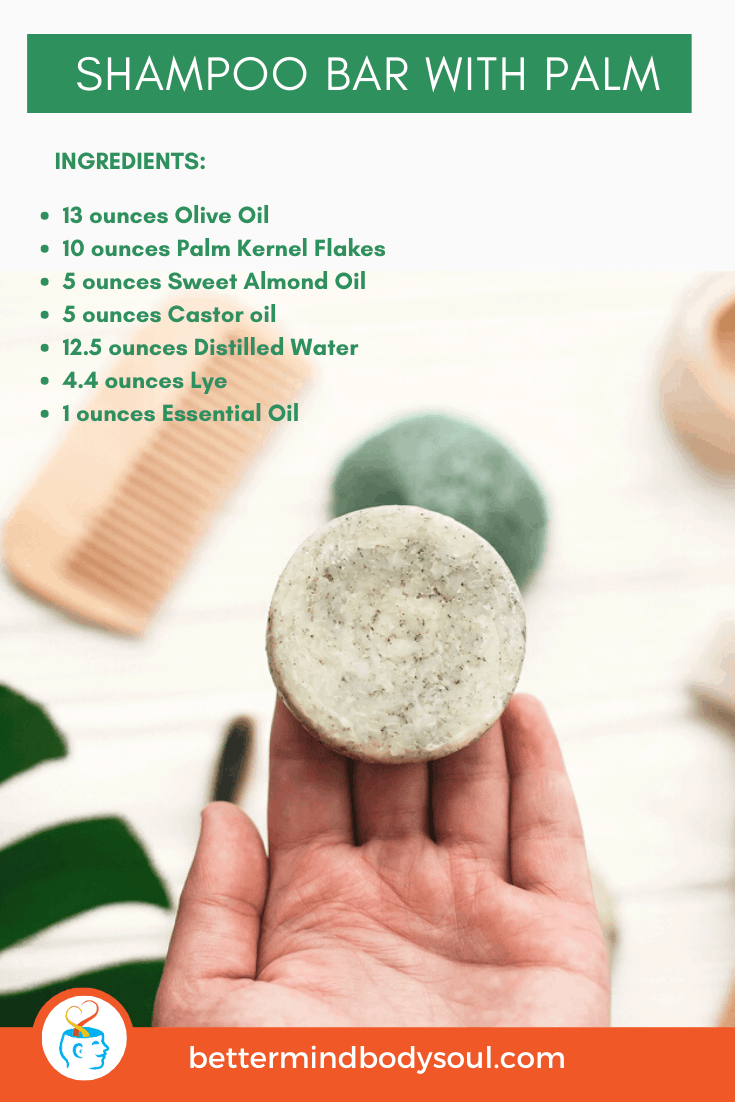
Ingredients
13 ounces Olive Oil
10 ounces Palm Kernel Flakes
5 ounces Sweet Almond Oil
5 ounces Castor oil
12.5 ounces Distilled Water
4.4 ounces Lye
1 ounces Essential Oil
If given the choice, most people would rather have moisture locked into their hair opposed to dryness. That’s why almond oil is a great addition to this natural shampoo recipe. It will bring shine and softness to your hair while adding essential fatty acids to your strands.
Directions
Combine olive oil, palm flakes sweet almond oil, and castor oil in a stainless steel pot and melt over medium/low heat. Remove from heat and allow to cool to 100 degrees Fahrenheit.
Outside, wearing proper safety gear including gloves and a mask, pour lye crystals into water and stir until dissolved. Allow to cool to 100 degrees Fahrenheit. If oils or lye water are not cooling at the same rate, use a cold water bath in the sink.
When both the lye water and oils are at the correct temperature, pour lye water into oils and mix with a hand or stick mixer until medium trace.
Add essential oil and blend well. Pour into mold and insulate for 24 hours. Remove from mold and cut. Allow to cure for 4-6 weeks in a cool, non-humid location.
Coconut Oil Shampoo Bar Recipe
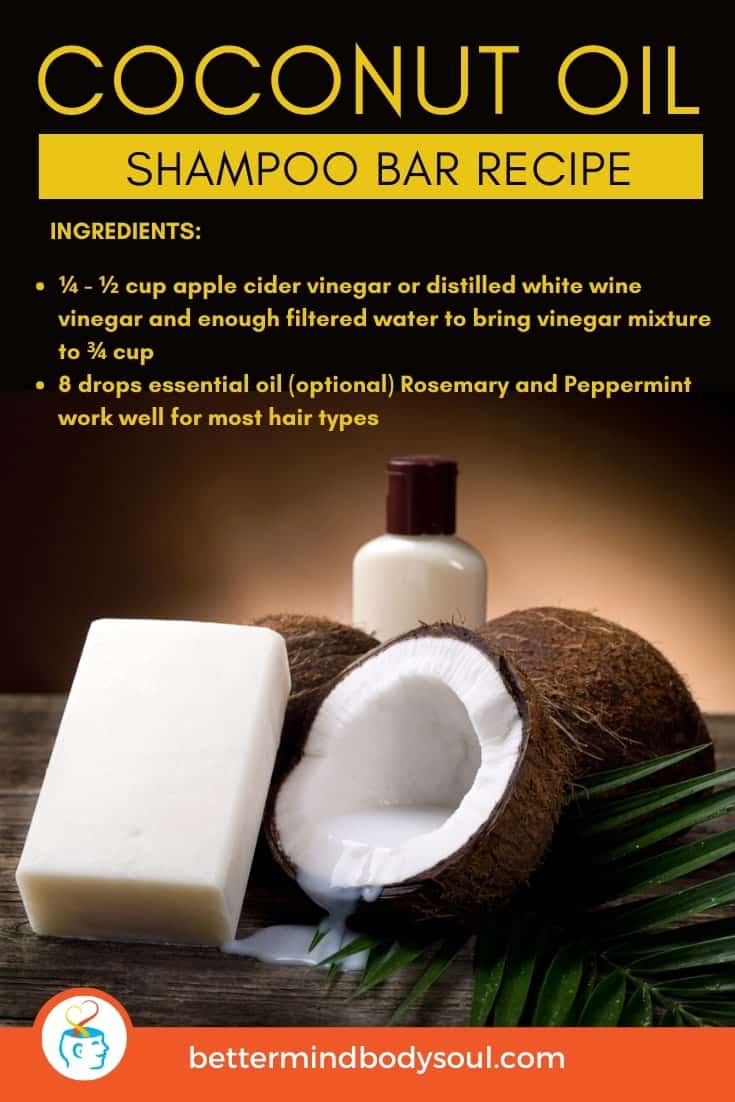
Ingredients
¼ – ½ cup apple cider vinegar or distilled white wine vinegar and enough filtered water to bring vinegar mixture to ¾ cup
8 drops essential oil (optional) Rosemary and Peppermint work well for most hair types
Rosemary oil is particularly strong but when diluted correctly in a recipe like this you will find that you’ve created a shampoo that promotes nerve growth, improves circulation, and fights inflammation. Peppermint oil holds antimicrobial compounds and also works as an antiseptic. It has been known to help stimulate hair growth.
Directions
It’s been almost two years since I’ve purchased shampoo. Yet my hair is softer, healthier, less frizzy, and much more manageable. I encourage everyone to at least give it a try, regardless of hair type!
Luxury Bar Shampoo Recipe
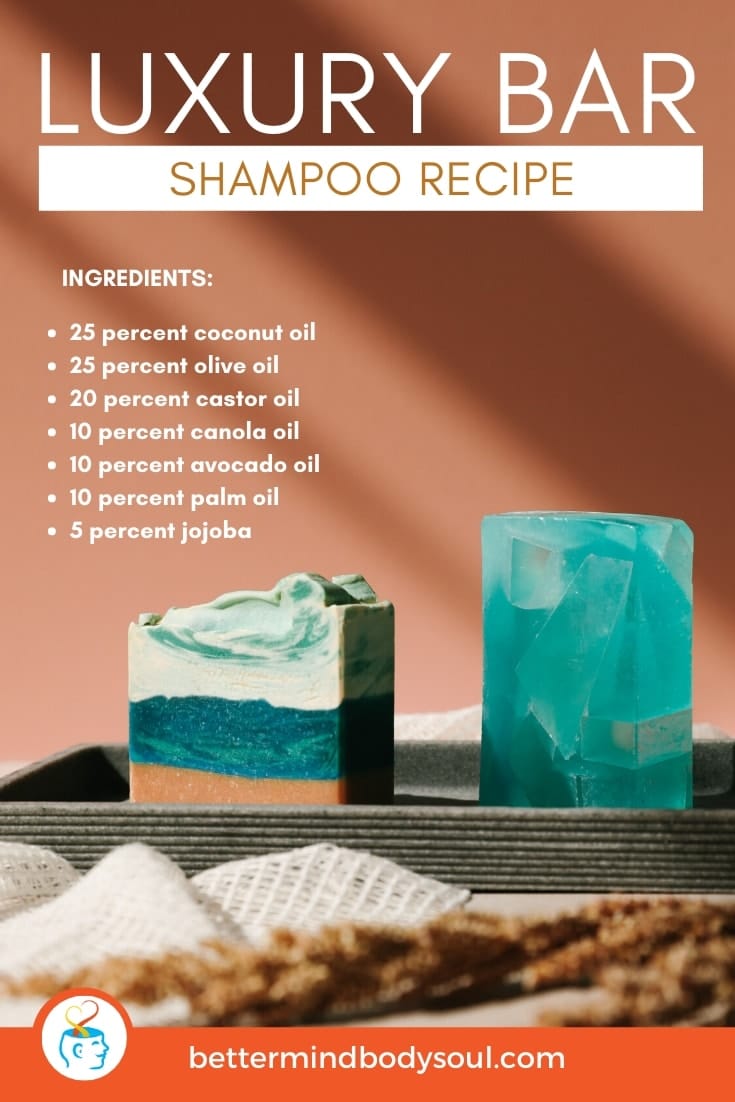
Ingredients
25 percent coconut oil
25 percent olive oil
20 percent castor oil
10 percent canola oil
10 percent avocado oil
10 percent palm oil
5 percent jojoba
This recipe focuses on oils alone. Each one of these ingredients brings its own set of benefits when used on the hair, but overall moisture is unbeatable. We are seeing avocado oil for the first time, which is another superfood/ingredient in natural shampoo. It helps reduce dandruff, detangle, and prevent breakage.
Directions
Things You Will Need
Safety gloves and goggles
Soap pot
Kitchen scale
Glass pitcher
Mason jar with lid
Plastic pitcher with lid
Thermometer
Measuring cups
Spoons, spatula
Stick blender
Molds
- First be sure to have your goggles and rubber gloves on. As you’ve seen in other directions lye is caustic when mixed with water and can be dangerous.
- Place a pitcher on the scale and zero out the weight. Add distilled water to the pitcher until it weighs the amount you need.
- Place a mason jar or plastic pitcher on the scale and zero out the weight. Add the amount of lye you need and close the lid tightly and put in a safe place. CAUTION!! Static cling can cause lye flakes to fly up and stick to your gloves or shirt sleeves. If this happens remove them immediately.
- Slowly add the lye to the pitcher of water. Do not do it the other way around and don’t make any splashes during pouring.
- Stir the mixture gently until the lye is dissolved. The mixture will heat up, which is normal, immediately rinse the tool you used to mix.
- Put the lid on the lye-water pitcher and set it in a safe place away from children, pets and anyone else.
- Put the soap pot or a glass pitcher onto the scale and zero out the weight.
- Weight your oils one by one. Make sure to zero out the weight after each oil. Pour slowly. You can always add more but you can’t take them out once they are added. HINT: Weigh the solid soap making oils like coconut, palm, cocoa butter, or shortening in the soap pot. Weigh the liquid oils like olive, sunflower, canola, or castor separately in a glass pitcher and set aside.
- Put the soap making pot with the solid oils on the stove over medium-low heat. Slowly melt the oils while stirring gently. Monitor the temperature with a thermometer. Turn off the heat when the oils get to about 110ºF. Keep stirring until all the solid oils are melted.
- Make sure all the soap additives in your recipe, such as color and fragrance, are ready to go. Place all the spoons, measuring cups, spatulas, and whisks you need nearby. Once you begin, it is required that you move along from step to step without interruption.
- Grab the stick blender but leave it off for the moment.
- Slowly add lye-water mixture to the soap pot. The oils will immediately start to turn cloudy. Using the stick blender as a spoon, but not turning it on, blend the lye-water into the oils. This is the beginning of the saponification process, which is the chemical reaction that turns your mixture into soap.
- Set the lye pitcher aside in a safe place.
- While stirring the lye water and oil mixture with the stick blender, turn it on in short bursts. To start with, blend for 3 to 5 seconds. Then, turn it off and stir some more. Repeat this process and keep blending in short bursts until the oils and lye-water are completely mixed. At this point, it is nearing trace, which we discussed in a previous recipe. This indicates that emulsification has occurred. You can test trace by dipping a spoon into the mixture and letting it drip back into the pot. If there is a track on the spoon the mixture is ready even if it isn’t thick.
- Once the soap mixture has been blended but before it is too thick, slowly add the fragrances or essential oil mixture. Use the stick blender but don’t turn it on.
- If you are adding extras like herbs, natural exfoliants, or flower petals this is the time to do it. Turn the blender on for one pulse to make sure they are blended well.
- Now add your colorant. You can create a bar that is one solid color or use swirls. For one color blend it in well. To make a swirl, put ½ cup of soap mixture into a glass measuring cup. Add the colorant to that and blend. Then slowly pour the colored soap into the corner of the soap pot. Using a rubber spatula, swirl the colored soap through the pot. If you stir too much you’ll ruin the swirls.
- Pour the raw soap into a mold using a back and forth motion to spread the soap evenly. Scrape the last thick bits of soap out of the pot with a rubber spatula. If the top of the soap in the mold is uneven, smooth it out with the spatula.
- Pick the mold up and gently tap it on the countertop to dislodge air bubbles that may have been trapped in the mixture.
- Set the soap in a warm, safe place to set up and begin curing. The soap mixture heats up as the saponification process starts. If the temperature of the room is chilly, lay a towel around or over the mold to keep it warm and keep the reaction going strong.
- Let the soap sit for 24 hours to harden. When you clean up be sure to use your gloves and goggles.
- After 24 hours pop the soap out of the mold. You should let it sit for four weeks to cure before using.
Conclusion
In the end, making shampoo for ourselves won’t only save us from letting toxins and chemicals penetrate our bodies through the pores on our heads. But it also enables us to find what ingredients work for us and play with the creation process until we find the perfect recipe for our unique head of hair.
It may be one of these or it may be a base recipe you morph from ones that you try. You may even need a natural shampoo for babies. Either way, if you enjoyed this article please let us know in the comments section below. Share it with any friends who may be interested in how to make natural shampoo.
The post 15 Natural Shampoo Recipes: Cleaning Your Hair The Green Way appeared first on Better Mind Body Soul.
No comments:
Post a Comment